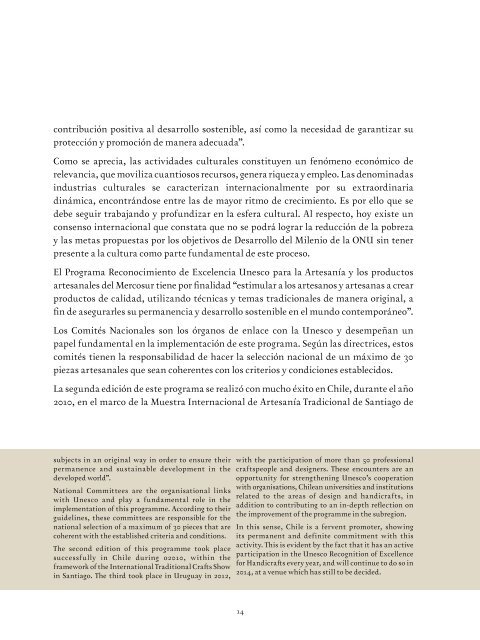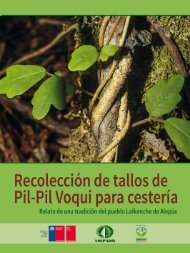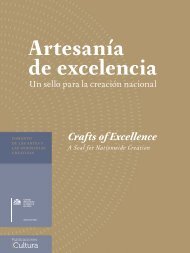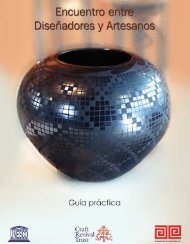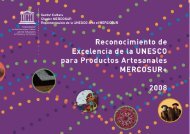artesania-excelencia
artesania-excelencia
artesania-excelencia
You also want an ePaper? Increase the reach of your titles
YUMPU automatically turns print PDFs into web optimized ePapers that Google loves.
contribución positiva al desarrollo sostenible, así como la necesidad de garantizar su<br />
protección y promoción de manera adecuada”.<br />
Como se aprecia, las actividades culturales constituyen un fenómeno económico de<br />
relevancia, que moviliza cuantiosos recursos, genera riqueza y empleo. Las denominadas<br />
industrias culturales se caracterizan internacionalmente por su extraordinaria<br />
dinámica, encontrándose entre las de mayor ritmo de crecimiento. Es por ello que se<br />
debe seguir trabajando y profundizar en la esfera cultural. Al respecto, hoy existe un<br />
consenso internacional que constata que no se podrá lograr la reducción de la pobreza<br />
y las metas propuestas por los objetivos de Desarrollo del Milenio de la ONU sin tener<br />
presente a la cultura como parte fundamental de este proceso.<br />
El Programa Reconocimiento de Excelencia Unesco para la Artesanía y los productos<br />
artesanales del Mercosur tiene por finalidad “estimular a los artesanos y artesanas a crear<br />
productos de calidad, utilizando técnicas y temas tradicionales de manera original, a<br />
fin de asegurarles su permanencia y desarrollo sostenible en el mundo contemporáneo”.<br />
Los Comités Nacionales son los órganos de enlace con la Unesco y desempeñan un<br />
papel fundamental en la implementación de este programa. Según las directrices, estos<br />
comités tienen la responsabilidad de hacer la selección nacional de un máximo de 30<br />
piezas artesanales que sean coherentes con los criterios y condiciones establecidos.<br />
La segunda edición de este programa se realizó con mucho éxito en Chile, durante el año<br />
2010, en el marco de la Muestra Internacional de Artesanía Tradicional de Santiago de<br />
subjects in an original way in order to ensure their<br />
permanence and sustainable development in the<br />
developed world”.<br />
National Committees are the organisational links<br />
with Unesco and play a fundamental role in the<br />
implementation of this programme. According to their<br />
guidelines, these committees are responsible for the<br />
national selection of a maximum of 30 pieces that are<br />
coherent with the established criteria and conditions.<br />
The second edition of this programme took place<br />
successfully in Chile during o2010, within the<br />
framework of the International Traditional Crafts Show<br />
in Santiago. The third took place in Uruguay in 2012,<br />
with the participation of more than 50 professional<br />
craftspeople and designers. These encounters are an<br />
opportunity for strengthening Unesco’s cooperation<br />
with organisations, Chilean universities and institutions<br />
related to the areas of design and handicrafts, in<br />
addition to contributing to an in-depth reflection on<br />
the improvement of the programme in the subregion.<br />
In this sense, Chile is a fervent promoter, showing<br />
its permanent and definite commitment with this<br />
activity. This is evident by the fact that it has an active<br />
participation in the Unesco Recognition of Excellence<br />
for Handicrafts every year, and will continue to do so in<br />
2014, at a venue which has still to be decided.<br />
14


